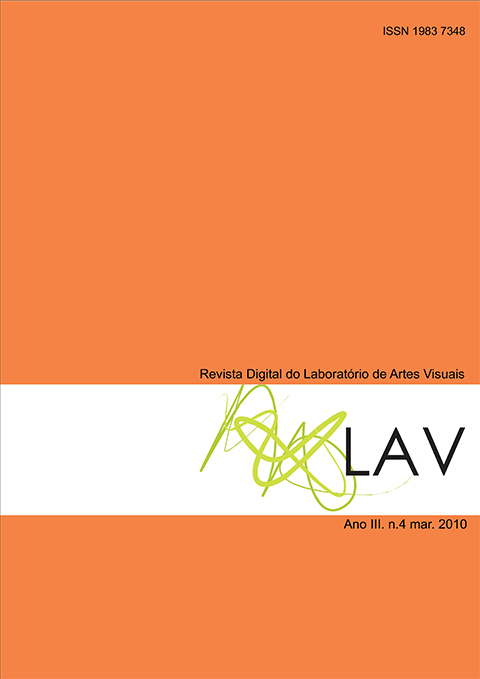Navigating the maze with Marcel Duchamp
DOI:
https://doi.org/10.5902/198373482204Keywords:
Contemporary art, Marcel Duchamp, Maze, AndrogenesisAbstract
To show how the works of the artist Marcel Duchamp insert in Contemporary Art and how the existence of its several fragments, sketches and studies are central points for the construction of a world of reveries that brings separate concepts in a labyrinthine way. The studies and works of Duchamp are parts of a maze that runs through time-space and whose marks are strongly associated to the way of thinking the Contemporany Art when it includes the other. What passes through the span of the other as co-artist carries in itself something subjective, what made possible to approach several chains of thing, making possible for then to find themselves through this research whose concepts were outline during its accomplishment. To analyse and research are part of the developed process and bring the aprroach between the works of Duchamp and whats I have done during some years throug the Art.Downloads
References
BACHELARD, Gaston. La Poétique de l`Éspace. Paris: Presses Universitaries de France, 1961, p.200-01.
BAILLY, Jean-Christophe. Marcel Duchamp. Paris: Fernand Hazan, 1984, p.5-6.
BERGAMO, Mônica. É arte ou não é?. FOLHA DE S.Paulo, caderno Ilustrada, domingo 17 de outubro de 2004.
BORGES, Jorge Luis. Obras completas. Vol2. Lisboa: Teorema, 1998. p.314,366,517.
BUREN, Daniel. Daniel Buren: textos e entrevistas escolhidos(1967-2000)/ organização Paulo Sergio Duarte [tradução, Ana Maria Castro Santos, André Sena, Lúcia Maia]- Rio de Janeiro: Centro de Arte Hélio Oiticica, 2001, p.16.
CABANNE, Pierre. Marcel Duchamp: engenheiro do tempo perdido. São Paulo: Perspectiva, 2001, p.24.
CALVINO, Ítalo. As cidades invisíveis. Tradução Diogo Mainardi. São Paulo: Companhia das Letras, 1990, p.67.
COSTA, Cláudio da. A arte moderna e contemporânea: a lógica da superfície em dois momentos. Disponível em: http:www.digitagrama.com.br . Acesso em: 2005.
DA VINCI, Leonardo, apud CHEVALIER, Jean; GHEERBRANT, Alain. Dicionário dos símbolos. Rio de Janeiro: José Olímpio, 1982, p.530.
DELEUZE, Gilles; GUATTARI, Félix. Mil Platôs: Capitalismo e Esquizofrenia. Vol1. Tradução Aurélio Guerra Neto e Célia Pinto Costa. Fio de Janeiro: Ed.34, 1995, p.15.
DUCHAMP, Marcel. Escritos. Duchamp du signe. Barcelona: Gustavo Gili, p.42,164.
DUCHAMP apud CABANNE, Pierre. Marcel Duchamp: Engenheiro do tempo perdido. São Paulo: Ed.Perspectiva S.A., 2001, p.47,110.
HABERMAS, Jurgen. Pensamento pós-metafísico: estudos filosóficos. Rio de Janeiro: Tempo Brasileiro, 1990. p.237.
HEARTNEY, Eleonor. Pós-Modernismo. São Paulo: Cosac & Naify, 2002, p.9.
MATOS, Olgária F. http://www.patio.com.br/labirinto/paisagensurbanas.html.
MEREJKOWSKI, Dimitri. The romance of Leonardo da Vinci. Bernard Guilbert Guerney, tr.New York. The Modern Library, 1928, p.510-11.
RANCIÈRE, Jacques. Autor morto ou artista vivo demais? Folha de São Paulo, cadeno mais! São Paulo, 6 de abril de 2003.
VELLOSO, Rita de Cássia L. O Cotidiano Selvagem: a arquitetura na internacional “situtionniste”. Entre riscos & rabiscos. Publicação dos alunos da Faculdade de Arquitetura e Urbanismo Izabela Hendrix, set/out 2002, p.17.
VENEROSO, Maria do Carmo F. Caligrafias e escrituras: diálogo e intertexto no processo escritural nas artes do século XX. [Tese de Doutorado em Estudos Literários]. Belo Horizonte:Faculdade de Letras da UFMG, 2000, p.173.
WITTGENSTEIN, Ludwig. Investigações Filosóficas; Tradução Marcos G. Montagnoli. Rio de Janeiro: Vozes, 1994, p.244.






